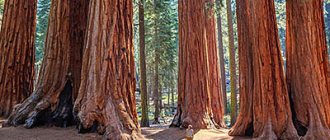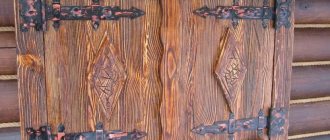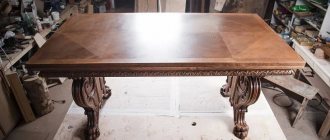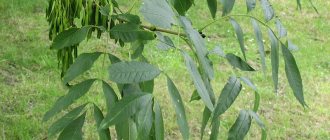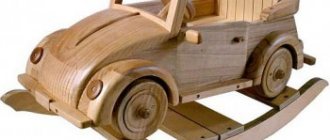When we hear the phrase - mahogany, luxurious furniture in rich houses, musical instruments and, of course, majestic trees pop up in our minds. Even before our era, to the famous King Solomon, merchants brought such wood from Ophir, the center of eastern trade of that time. According to the famous historian I. Flavius, the material was used in the construction of the temple, its palace and for the manufacture of harps and other stringed instruments.
Scientists believe that this was the wood of the red sandalwood tree, which today grows in Sri Lanka and India. What is this unique plant? What is remarkable about its wood and where is it used? The answers to these questions will help you plunge into the wonderful world of majestic trees. Find out the height of the sequoia here!
Red sandalwood can reach up to 9 m in height. Its hard wood has a fine grained character, is wonderfully workable and is suitable for making musical instruments mentioned in ancient books.
Mahogany - royal material
A symbol of luxury and prosperity over the past four centuries. Rare mahogany wood is one of the best materials for the production of luxury, exquisite furniture.
It is equally highly valued by craftsmen and designers, as well as by clients all over the world. You can cut complex and large parts from it. It has a deep, rich color and beautiful texture. Opens up wide horizons for creativity - solid red wood is easy to process, glue and even bend (some types).
Musical instruments, smoking pipes, boxes and expensive accessories are made from mahogany. Wall panels and cabinets made from it decorate the royal bedrooms. And tables are considered the most expensive and beautiful products. The tabletop is in front of your eyes, the guests’ eyes are riveted to it.
The main secret is how to distinguish a valuable breed from a fake
The term “mahogany” includes a variety of types of wood. Not only are they obtained from different types of trees growing on all continents, but they also differ greatly in key indicators:
- Hardness
- Blossom
- Texture
But there is one common feature - a high price and not just beautiful, but even exquisite appearance.
In order for a material to have the right to be called “mahogany”, it must meet the following requirements:
- Made from a rare breed. As a rule, it grows in hard-to-reach places located close to the equator.
- Good to process. Although this may require special tools and technologies.
- Have a natural shade of red. From dark burgundy to pink, but it is imperative that the color does not fade over time. When covering a product with varnish, the master does not try to paint the surface. He only tries to emphasize the play of colors created by nature itself.
- Be sufficiently hard and durable. High-quality mahogany sometimes takes a very long time to dry. At the same time, the material significantly loses volume and weight, but its cost increases.
Combination of colors in clothes. Green
Billiard color or wormwood color.
Names, descriptions and photos of weeds that can be found in the garden
This shade in itself is not striking, but if you are noticed, it will be difficult to take your eyes off. Billiard is the color of calm, respectability, wisdom and good luck. And what woman doesn’t suit the color of fortune? In addition, with this shade you can create bright, grandiose combinations.
Consider a combination of mugwort and soft pink, Victorian pink, rose, deep red, alizarin, orange, coppery auburn, pale yellow, apricot, thrush egg, light green, taupe, light blue, lilac, orange beige, yellow-brown and chocolate color.
Turquoise green color.
Rare, bright and calm at the same time. He inherited the versatility of turquoise shades and the calmness of dark turquoise. The color will fit into any wardrobe. Combinations with this color can be restrained and modestly intelligent. This color can be present both in a business style and in a casual one for relaxation.
Jewelry made of gold, silver, emeralds will look good next to this color. It is better to choose transparent stones: pink, blue, orange, cold green shades. Wooden decorations will go well with it.
What does turquoise green go with? Combinations are not intrusive, but with character can be obtained with soft pink, coral lilac-pink, pale sand, pink coral, ocher, regatta, emerald, soft blue, dark pink, taupe, lilac, blue-lilac, beige-pinkish, silver, gold, bronze, brown.
Atlantis or turquoise green color.
Self-confidence, independence, personal responsibility, creativity - the qualities that the color “Atlantis” expresses. In this color you will feel free from the “impossible”, and your partners will see limitless potential in you. The Atlantis color is universal and suitable for all color types.
Turquoise green color is combined with red, red rose, saffron, yellow-orange, gold, golden, aquamarine, malachite, cobalt, royal blue, blue, glycine, lilac, light pink-beige, brown, dark brown
Spring green color
This is a light shade of blue-green - one of the few universal colors that is perfect for representatives of all color types. You are probably surprised by this name, because spring greens usually look light green in color. But this color fits perfectly into the spirit of the spring mood. This is a very energetic color that can awaken you from winter dullness and apathy.
This shade of blue green goes well with pronounced colors. Such as: geranium, pink, iris, red, dark red, orange, orange sorbet, sand, light yellow, gold, viola, blueberry, light lilac, lilac, bright purple, brown, dark brown.
Materials used from the site - www.julia-bannykh.livejournal.com/39866.html
Story
Durable and beautiful wood is one of the first elements of luxury to appear in our civilization. People realized very quickly how good this stuff was.
Mahogany - in fashion since 965 BC
The most ancient mention of rare varieties of wood is found in the Third Book of Kings (one of the books of the Bible). It tells how the Queen of Sheba, having learned about the wisdom of Solomon, decided to test him with her riddles. She did not arrive in Jerusalem empty-handed. The ship brought a lot of gold, precious stones, incense and mahogany.
The wood was brought from Ophir. Scientists are still arguing about where this country was located. Most likely, we are talking about India. And mahogany is one of the varieties of sandalwood. Although, it is possible that rosewood was delivered to Solomon from Latin America.
The Israeli king Solomon, considered the wisest of rulers, used mahogany to decorate the Temple, his own palace and the production of musical instruments. I made a railing and a harp. Almost three thousand years have passed, and we still use mahogany for harps, guitars, luxury furniture and home decoration.
From kings to emperors
Trade ties between Europe, Asia and Africa have long remained complex and fragile. Therefore, trade was carried out mainly in small and expensive goods. It was difficult for a caravan traveling along the Silk Road to take a lot of wood.
Therefore, for a long time, mahogany remained the property of only the supreme rulers. But not all, but only those who ruled the largest and richest countries. Residents of India and China are luckier. There, not only rajahs and emperors, but also their nobles could afford a table made of a rare breed or at least a box.
The Birth of French Antiques
By the end of the Middle Ages, Europe began to experience an acute shortage of quality wood. Slash-and-burn agriculture, the construction of houses and ships, and constant wars took their toll. The problem was solved by great geographical discoveries.
In America, India and Southeast Asia, travelers, naturalists and entrepreneurs found many new plant species suitable for the production of furniture and interior items.
This is how an offer appeared on the market.
King Philip II of Spain was the first to appreciate the beauty of mahogany. By his order, wood was widely used in the decorative decoration of the Escorial monastery. The monastery soon turned into one of the most beautiful palaces in Europe and a royal residence.
And widespread demand was created by Louis XIV de Bourbon, the most majestic king of France. The first European monarch to move from the theory of absolute monarchy to practice. His nobles no longer needed to build well-fortified castles with thick walls and high towers. The king protected them from the encroachments of their neighbors. Therefore, the dukes and marquises began building magnificent palaces. Beautiful buildings that needed to be furnished with equally exquisite furniture.
It was at this time that mass production of luxury goods began. Now we buy them at auctions as the most expensive antiques. Please note - almost all antique furniture is made of mahogany.
Viva Victoria
During the reign of Queen Victoria, the British Empire reached the zenith of its power. She was no longer just “the mistress of the seas.” The sun literally never set on the British Empire - its possessions spread throughout the world. This made trading easier, which meant prices fell.
Throughout the 19th century, the assortment of rare wood dealers grew, and prices fell. Tables, cabinets, chests of drawers and secretaries made of mahogany began to appear in the living rooms and bedrooms of not only nobles, but also merchants, officials, and minor nobles.
By the end of the century, naturalists had found and described almost every species of plant whose wood we now call “mahogany.” And entrepreneurs arranged their supply to Europe.
Modernity
In our times, the value of rare breeds has not decreased at all, and in some cases has even increased. Most of the plants used as raw materials for wood production are subject to environmental laws. Even in countries where logging is allowed (for example, Indonesia), there are significant restrictions on exports.
But no matter what dams governments build in the way of valuable goods, the flow will always find cracks and crevices, break through and flow with renewed vigor. Now up to 80% of all mahogany is smuggled out of producing countries.
They then go to an exchange or store in Singapore. Boards are sold individually. The best samples, including slabs, go to auction. And all this in order to decorate your home.
Reproduction
The methods used to propagate suckerweed are cuttings, rooting of layering and germination from seeds. Oddly enough, it is vegetative methods that give the worst results: no more than ⅓ of the bush shoots take root and grow.
Cuttings are prepared before winter. They should be 15 cm long and have several leaves. They are pre-treated with phytohormones, and the sections are sprinkled with charcoal. For rooting, the shoots are placed in boxes with a mixture of peat and sand, left at a temperature of 16–18°C, and watered periodically. The branches that have taken root over the winter are transplanted into the ground.
When propagating by layering, circular cuts are made on the side shoots and pressed to the ground, sprinkled with soil. Layers are separated from an adult plant after the roots appear. Otherwise, after a few months the cut shoot is removed.
Plantings of basal children of the eelgrass, which are carefully separated from the mother specimen and transferred to a new place, take root more successfully.
Shrub seeds can be sown in late autumn. This way they will not lose their germination capacity and will undergo winter stratification. Place them in loose prepared soil to a depth of 7–10 cm, sprinkle with sawdust or leaves. After the snow melts, water generously. You can plant plant seeds in the spring, but to ensure germination you need to keep them at a temperature of +8–10°C for several weeks. In the first season, young shoots reach a height of 30–40 cm; in subsequent years, the growth of the bush slows down and is about 15 cm per year.
Trees
They belong not only to different species, but also to different genera. For example, red sandalwood and padauk belong to the genus Pterocarpus and the legume family. And the rose tree is already a member of the Jacaranda genus and the Bignoniaceae family.
Yes, you heard right - these beautiful purple flowers that your wife loves so much also grow in the tropics. Only there their sizes are such that the trunk can be sawed into boards. And use them to make a table on which you will place a flower pot.
Red sandalwood
King Solomon knew a lot about luxury and beauty. The tree, locally called Ronga Chandan or Rakta Chandan, is native to Eastern India. Height - up to 8 meters, trunk diameter - from 0.5 to 1.5 meters. It’s clear - larger width boards and slabs are highly valued.
The first three years it grows very quickly, reaching a height of up to 5 meters. Then the growth rate drops. Young trees are ground into powder; Indians use it to make medicines and cosmetics.
Interestingly, red sandalwood and regular sandalwood are completely different plants. They are only slightly similar to each other.
Paduc
It grows mainly in Southeast Asia - Burma, Malaysia, Indonesia. It is also found in West Africa - in Zaire, Cameroon, Nigeria. Huge trees can reach heights of 40 meters or more. The tree sap contains latex, but in small quantities, so it is not used for rubber production.
African wood varieties are bright red in color, but darken over time, changing to brown, and in some places even black. When drying the board in direct sunlight, the darkening occurs unevenly. A beautiful transition is formed, highly valued by designers and furniture makers.
African padauk is used to make backgammon boards and billiard cues. The best and most expensive slabs are used to produce tables. A large copy with a beautiful color gradation can cost tens of thousands of dollars.
Although paduk is easy to process, only experienced craftsmen can work with it. You need to know a lot of subtleties so as not to spoil an expensive board.
mahogany tree
When they say "mahogany" they mean mahogany. And when they say “mahogany,” they mean mahogany. Grows mainly in Central and South America. It was he who was brought to Europe by the followers of Christopher Columbus to make furniture for the court of King Louis.
From Swietenia mahagoni, Spanish colonists made a cross for the church at Santa Domingo, one of the first built in the West Indies. Less religious conquistadors used the wood to repair their caravels and galleons.
This cross and other interior elements made from mahogany have been perfectly preserved from 1514 to the present day in perfect condition. The plant has become the national symbol of the Dominican Republic.
Almost all English furniture produced at the beginning of the 18th century and surviving to this day is made from mahogany.
Brazilwood
More than 150 plant species found in warm latitudes of both hemispheres. Caesalpinia hedgehog (thorny), also known as the “fernambuco tree”, gave its name to the whole country - Brazil. The Portuguese called it "Pau-Brazil", cut it down and exported it. Pedro Alvares Cabral of course wanted to call the new lands Terra da Vera Cruz (Land of the Holy Cross). But his associates became interested in exporting wood, so now we use the name “Brazil”.
By the way, the thorns do not grow on the branches or on the trunk of Caesalpinia, but on the fruits. By the way, they used to make red dye for fabrics. So far the chemical industry has not been able to create synthetic paints.
And Caesalpinia wood is still highly valued. Especially among musicians. It makes excellent stringed instruments and conductor's batons.
Fernambuco has a unique combination of qualities - it is hard, but light and elastic. Almost ideal material for the production of furniture, especially tables.
Palisnadre
A typical story for rare wood species - names are given by entrepreneurs, smugglers, sailors, not naturalists. They are primarily interested in the consumer properties of the material, and not in botany. Rosewood is a prime example of this approach. This name includes a number of plants growing in tropical latitudes.
No matter how hard the botanists tried to correct the situation, nothing worked. Jacaranda, Dalbergia, and some other species can be sold under the name “Rosewood”. But you can be sure that the wood was delivered from the tropics, it is quite hard, has a beautiful color and intricate texture.
Jacaranda
Translated from Portuguese - “fragrant”. Belongs to the Bignonieceae genus and has beautiful flowers in all shades of blue. It grows not only in Latin America, but also in Africa, and even in Eurasia. But only in subtropical latitudes.
As a child, you probably read Alexander Volkov’s fairy tales about the Magic Land and the Emerald City. So, the famous villain Urfene Juice made his wooden soldiers from ordinary wood, and his generals from especially valuable wood. Yes, his general Lan Pirot was created from Jacaranda.
Smugglers are not good at botany, so they often call Jacaranda the “violet tree.” Especially those batches that come from Africa.
Dahlbergia − Rosewood
It is this species that the British consider “real mahogany.” That's what they call Rosewood. The French completely agree with them - they use the term Bois de rose. And, of course, the Portuguese are to blame for everything.
In the mid-19th century, at the height of the fashion for mahogany furniture, they began supplying Dalbergia en masse from Brazil. Thus, they seriously brought down prices on the market. Tables, boxes and musical instruments have become more accessible.
But this happy time lasted no more than a few decades. Very quickly, the thickets of Dalbergia, located in coastal areas, near the ports, were completely cut down.
These days, rosewood is much more expensive and is considered a rare breed. But the fashion for it did not pass. Therefore, cunning traders cut Dalbergia into thin veneers and paste them on guitars and harps made from ordinary European maple. We don’t do that - we only supply solid boards and slabs from which we create excellent countertops.
Dalbergia has two remarkable qualities - it tolerates high humidity well (does not absorb water) and has no odor. Therefore, humidors are made from it - boxes designed for storing cigars. To prevent tobacco from losing its wonderful qualities, it must be stored at a relative humidity of 68-72%. No other tree except Dalbergia will tolerate such conditions.
Pests and diseases
Caring for young trees must be careful. For the first five years of their life, they are covered with burlap during the cold season to prevent freezing and disease. The burlap should be dense and breathable.
Pests rarely attack a mature oak; it has a powerful root system and strong branches. The main enemies of the beech family are fruit moths and leaf rollers. A pest such as powdery mildew, known for its rapid and aggressive effects, is the most dangerous. The pest causes necrotic changes in the branches, up to the total death of the entire tree. The disease is easy to detect by the white coating on the leaves. By the end of summer, small black dots appear on the powdery coating - these are the bodies of the fungus. Powdery mildew can destroy a young plant, as it does not allow the shoots to become woody. The disease is spread by insects gnawing on leaves. After their attacks on the crowns, oak trees of any age can be affected.
Preventive treatment of branches is carried out with a mixture consisting of baking soda and water. If pests have already appeared, you need to immediately apply fungicides to completely neutralize the impact and destroy the parasites. In addition to fungicides, plants are treated with a solution of copper sulfate and colloidal sulfur.
Wood production
Felling
Today, production centers have shifted from Latin America to Southeast Asia. The main consumers here are Japan and China. Therefore, Singapore became the center of trade in valuable rocks. And the places of cultivation are Indonesia, Malaysia, and the Philippines.
Some species are planted artificially, but most trees are harvested from wild tropical forests. But, unlike Europe, here you will not find deep clearings. Valuable trees are rare. This is the difficulty of their extraction. Local loggers go deep into the jungle by boat and try to find trees located as close to the water as possible.
Poor peasants are engaged in felling; for them this is the only source of income. The work is very hard and dangerous - the jungle is full of predators, snakes and poisonous insects.
Primary processing and drying
This is where entrepreneurs and small companies get involved in the process. They organized production and warehouses in rural areas, closer to the logging sites. There, the trunks are cleared of branches, cut into logs and sent to the dryer.
A variety of technologies are used. From sophisticated modern vacuum dryers to conventional drying techniques under the scorching rays of the tropical sun. It all depends on the specific type of plant and the effect you want to get. Some varieties darken, others become lighter.
Only after this the wood is cut into boards. The largest and most beautiful logs are made into slabs - leaving the bark and sapwood to maximize the area of the product.
The last stage is sorting. Small boards, scraps and chips are sent directly to China. There they will be used to make tea boxes, boxes and musical instruments. Whatever is bigger, better and more expensive goes to Singapore.
Transportation
At the stage of export from the country of growth, smugglers come into play. Each government sets export quotas for valuable species. And he imposes huge taxes, because he considers the material to be his national treasure.
Of course, entrepreneurs exceed these quotas. The demand in the market is very high, and the price is always high. Officials understand this well and want to get a share of each delivery for themselves. Therefore, smugglers compete not so much with the official customs service, but with corrupt officials.
Wholesale trade in rare mahogany wood
Anything longer than 1 meter and priced at $50 is sold on exchanges in Singapore. Most of these places are designed as “family businesses”, small furniture stores. But in reality, these are auctions where exporters and wholesalers bargain with each other to get the best specimens.
At this stage, the mahogany is “washed”. Now it is no longer logs that are sold and bought, but boards - material for the production of furniture, musical instruments and other products. Through simple manipulations with documents, wood receives a new history. Some boards appear to come from Dalbergia, grown in South America. How amazing!
Planting and care
You can plant oak either in the spring, as soon as the snow melts, or in the fall, before frost sets in. For Russia, the best time is the spring months of March and April, and the best time in the fall is October and the first half of November.
Selecting a location
A place for planting on a summer cottage is chosen to be open and well lit. Maturation and growth directly depend on this. Red oak has a pronounced attitude towards light; it is quite light-loving. If the plant is planted on the shady side, the formation will be inactive and slow, and the oak will not bear fruit. Therefore, they choose an open area where the sun remains most of the day.
To begin with, when planting, you need to dig a small hole in the ground, then place drainage in it: dry leaves, crushed stone. The neck of the root should not be too deep and rest against the bottom of the hole.
Soil requirements
Tolerates soil that is overly acidic. Oak does not require special conditions for planting, but does not respond well to lime and high levels of moisture in the soil. The optimal soil composition is a mixture of peat, turf and sand.
Watering
The young tree is watered regularly, weeding around weeds that interfere with moisture absorption
It is especially important to water during hot and dry seasons. A month before leaf fall, they stop watering.
Preparation for winter begins, which the tree carries out independently.
Feeding
When planting a holly tree, it is not advisable to use organic fertilizers. Feed the soil with ammonium nitrate, mullein and urea.
Production of furniture from slabs - a fusion of modern technologies and natural materials
The invention of high-quality modern resins made it possible to make a real revolution in the furniture industry. Now cabinetmakers no longer need to process the edges of the boards. You can completely preserve their natural beauty. Leave the sapwood intact to highlight the beauty of the color transition from bright yellow to dark red.
The surface is leveled by pouring resin. After hardening, it forms a perfectly smooth, even and transparent surface. Sometimes fluorescent substances are specially added to the composition. So that the table glows quite a bit at night, emitting a magical, barely noticeable light.
Raw, “live” edges can seriously increase the size of a countertop made from solid rare wood. Each table turns out to be unique, like the plant itself from which it is made.
Sometimes glass inserts are used to emphasize the complex texture. This allows you to demonstrate the smallest details of the internal structure of the wood. Show how the conditions in which the plant existed changed.
The resins used in the manufacture of slab countertops are environmentally friendly, state-of-the-art materials. After hardening, they are completely odorless. They reach almost the same consistency as regular glass.
Unknown leader
So, what is the most common tree in Russia? The first place has been held for decades by the beautiful larch from the conifer family. Such a tree is truly unique: despite the fact that it is considered a relative of the spruce and pine, in winter it sheds its needles, just like deciduous representatives of the forests of the middle zone. Distinctive features of larch are the following characteristics:
- Trunk height up to 45 meters (dwarf varieties exist).
- Life expectancy up to 900 years.
- Gray-brown color and dense bark structure.
- The crown resembles a wide cone in shape.
- Soft needles are light green in color and fall in October.
- Small-sized (up to 4 centimeters) cones with tightly closed scales until ripening.
- Flowering period is May.
- The seed ripening period is early and mid-autumn.
